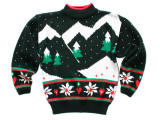 There are some people who have always held the belief that paying $20 for every T-shirt and $60 for every pair of jeans is too much money to spend on clothing. Recently, a lot more people have subscribed to that notion and have stopped buying everything new.
There are some people who have always held the belief that paying $20 for every T-shirt and $60 for every pair of jeans is too much money to spend on clothing. Recently, a lot more people have subscribed to that notion and have stopped buying everything new.
Thrift stores held an important place in American consumer society until the 1950s. It’s not a coincidence that declining secondhand purchases happened around the same time as the advent of credit cards and the widespread belief that the surefire way to keep the postwar economy afloat was to buy. And so Americans bought new stuff by the bunches: cars, homes, appliances and clothes.
Thrift stores faded into the background for several decades until making a big comeback in the past few years. According to the National Association of Resale Professionals, the number of resale stores increased by 7 percent in both 2011 and 2012.
There are several explanations for this. The Great Recession is still close by in the rearview mirror, and as property values drop and unemployment climbs, certain businesses not only stay afloat but thrive, including thrift stores (auto repair businesses also thrive as people hold on to older cars longer).
The average household spends $121 monthly on clothing. Despite a recent recession, we still buy a lot of clothing, wearing much of it only a few times before moving on and letting it fade into the forgotten depths of the closet. Although just 15 percent of clothing waste is reused or recycled, the clothes that are given a second life are often in good condition and still fashionable enough to be worn by someone else.
Much of secondhand clothing collected by USAgain and other textile recyclers wind up on the racks of thrift stores in the U.S.
Smart businesses adapt to what consumers want, and thrift stores are no different. Stores like Savers, which operates nearly 300 stores across the world, organize their clothing sections by size, color and style, just like any store selling new items. Doing this makes customers feel more comfortable and increases businesses as shoppers have an easier time finding what they want.
Thrift stores have also become dominant sellers of niche items and retro collectibles. Ragstock, a higher-end thrift store chain with outlets at malls, specializes in selling “ugly” holiday sweaters for themed parties. Ragstock also carries a large selection of vintage ’80s sweaters, ski jackets and cowboy boots—items that have come back in style and are in high demand among the fashion-forward.
Even as the economy recovers and people fall back into old spending habits, don’t expect thrift stores to disappear. With so much fast fashion available for purchase, Americans will continue buying clothing and getting rid of it when it’s no longer wanted, and hopefully, more of those items will be diverted from the trash and put on the shelves of thrift stores to be bought and worn again.
To paraphrase the old saying, one man’s trash is another man’s new wardrobe.
Quality sites
Reblogged this on Traders Apparel.